Pawllet | A Case Study on Blockchain in Decentralized eCommerce
Promotional video depicting Pawlet's main proposed features: A Desktop Crypto Wallet, and a Mobile App. Winner of the CareerKarma 'Best Project of the Week', Awarded May 2021
Pawlet
A case study in designing a mobile app experience that keeps your pets healthy, safe, and secure — powered by blockchain.
In November 2020, during my post-graduate studies at Kenzie Academy (Now a part of Southern New Hampshire University), I began designing a concept for a mobile application that empowers pet owners to manage their pet's personal information, schedule vet appointments, purchase pet goods, and more, but I wanted to take it a step beyond — and encapsulate it all within a secure, decentralized ecosystem, inspired by the initial
Web3 developments of the early 2020s, which would mark the arrival of concepts such as NFTs (Non-Fungible Tokens).
I labeled the project Manila 📁, a tongue-in-cheek name inspired by the nomenclature of the classic beige folders we've all used to store important documents at one point or another
(Fun Fact: It's also a City in the Philippines!)
Later on, the name would be changed to Pawlet, reflecting it's purpose more accurately as a Wallet centered around our Pawed friends.
Early Prototype - Figma (2021-2022)
The goal was to modernize that concept — giving pet owners a secure, digital way to store and share their pet's data, utilizing it to securely communicate within an ecosystem of trusted resources. By leveraging blockchain technology, Pawlett explored how decentralized tools could enable safer interactions with service providers, while giving users full control over their pet's health records and purchases in a trustless, transparent system.
01 | Discovery
I conducted research via user interviews on the subsequent questions through a combination of means, including Zoom and Typeform.com. I aimed to answer key questions such as:
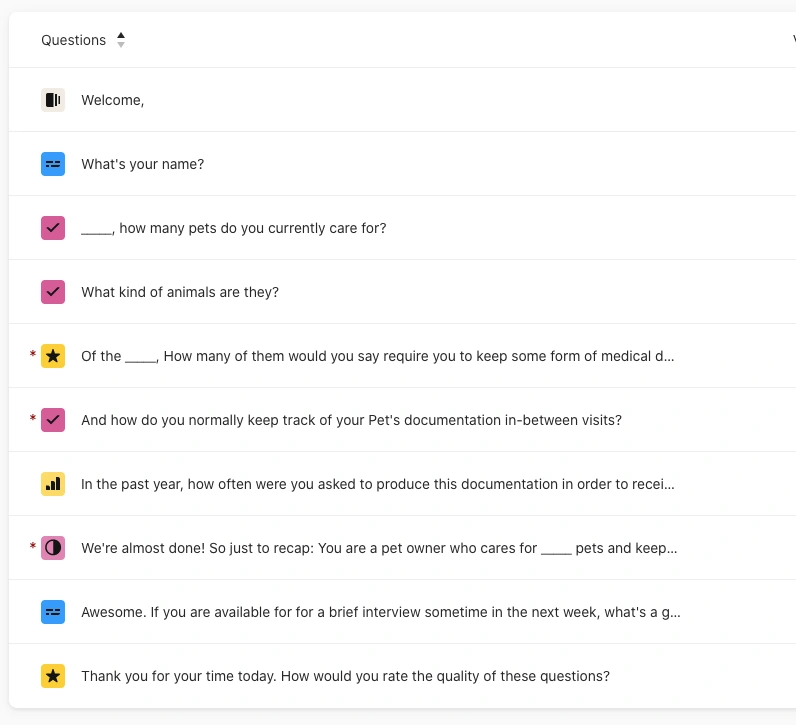
02 | Obtaining Insight
Using the data I gathered, I formulated personas and user stories that would be exceptional matches for utilizing the conceptual platform. For example;
As a pet owner, I want to use a mobile app to keep track of my pet's health, by setting appointments directly with pet service providers, as well as buy pet products directly from local suppliers.
Ex.

Sample User Persona developed during ideation
03 | User Flow
I composed a user flow that best exemplified the situations faced by users looking to retrieve their pet's documents/health information.
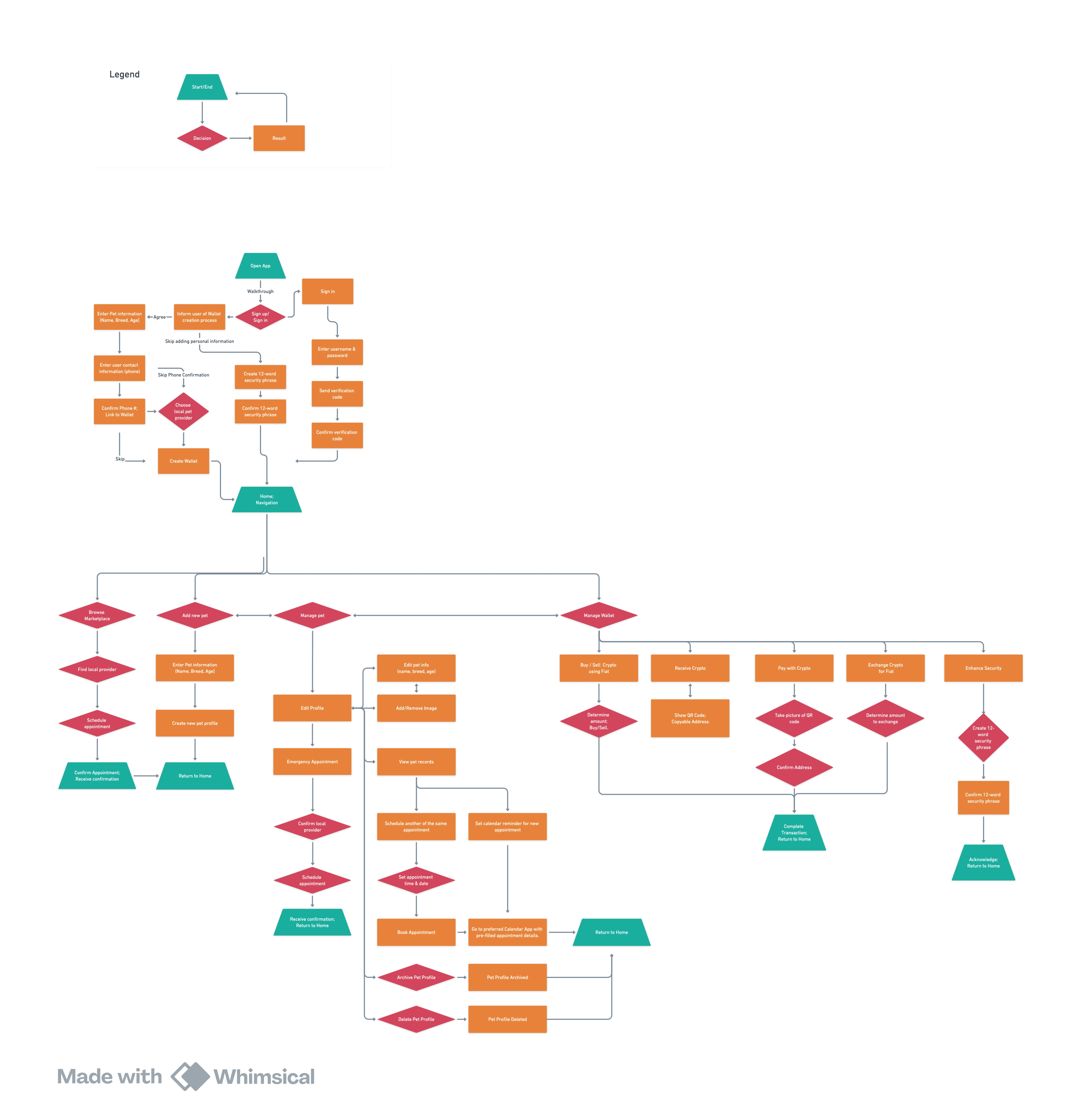
User Flows for ideal UI
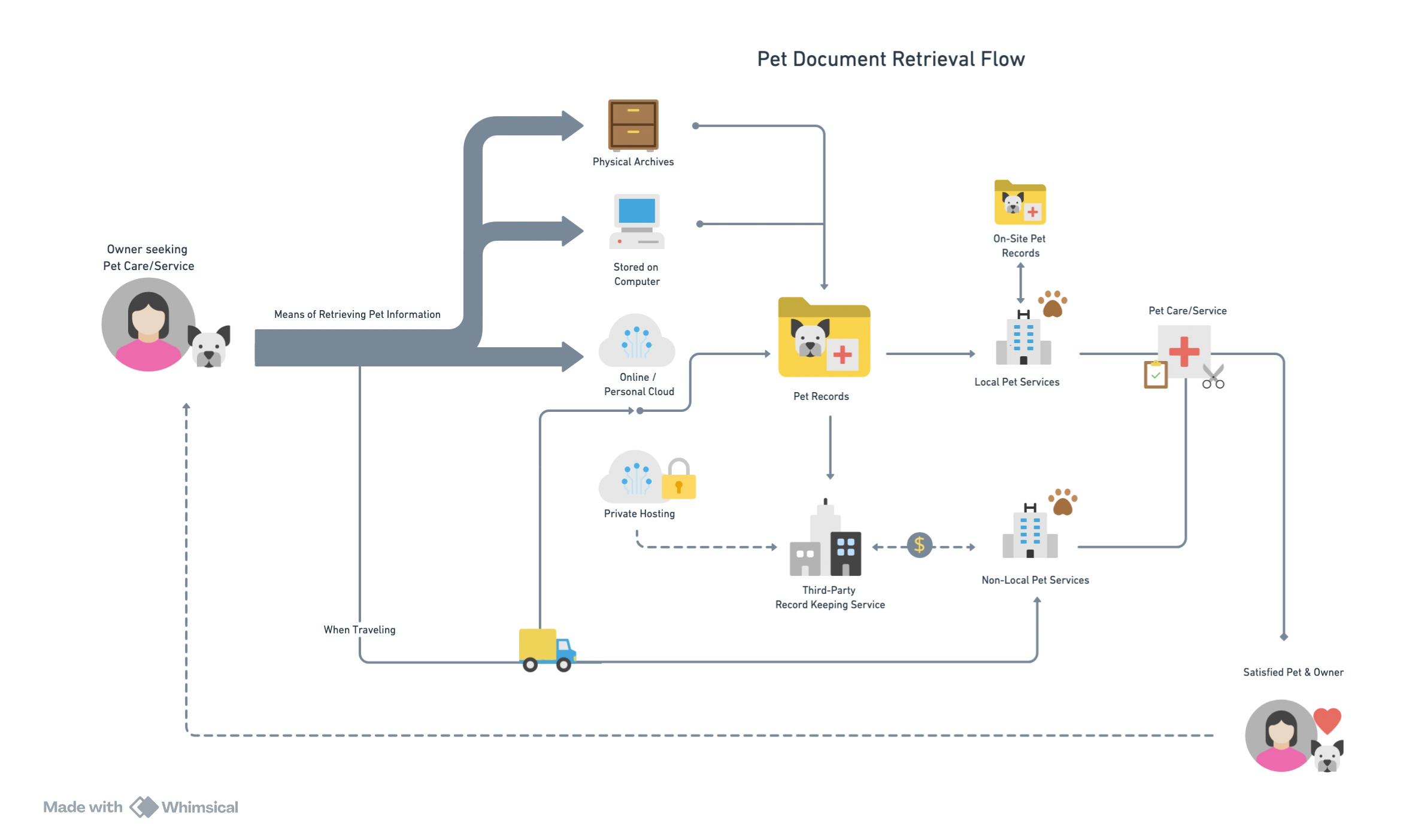
Pet Document Retrieval Flow - Methods of storing pet data observed during research
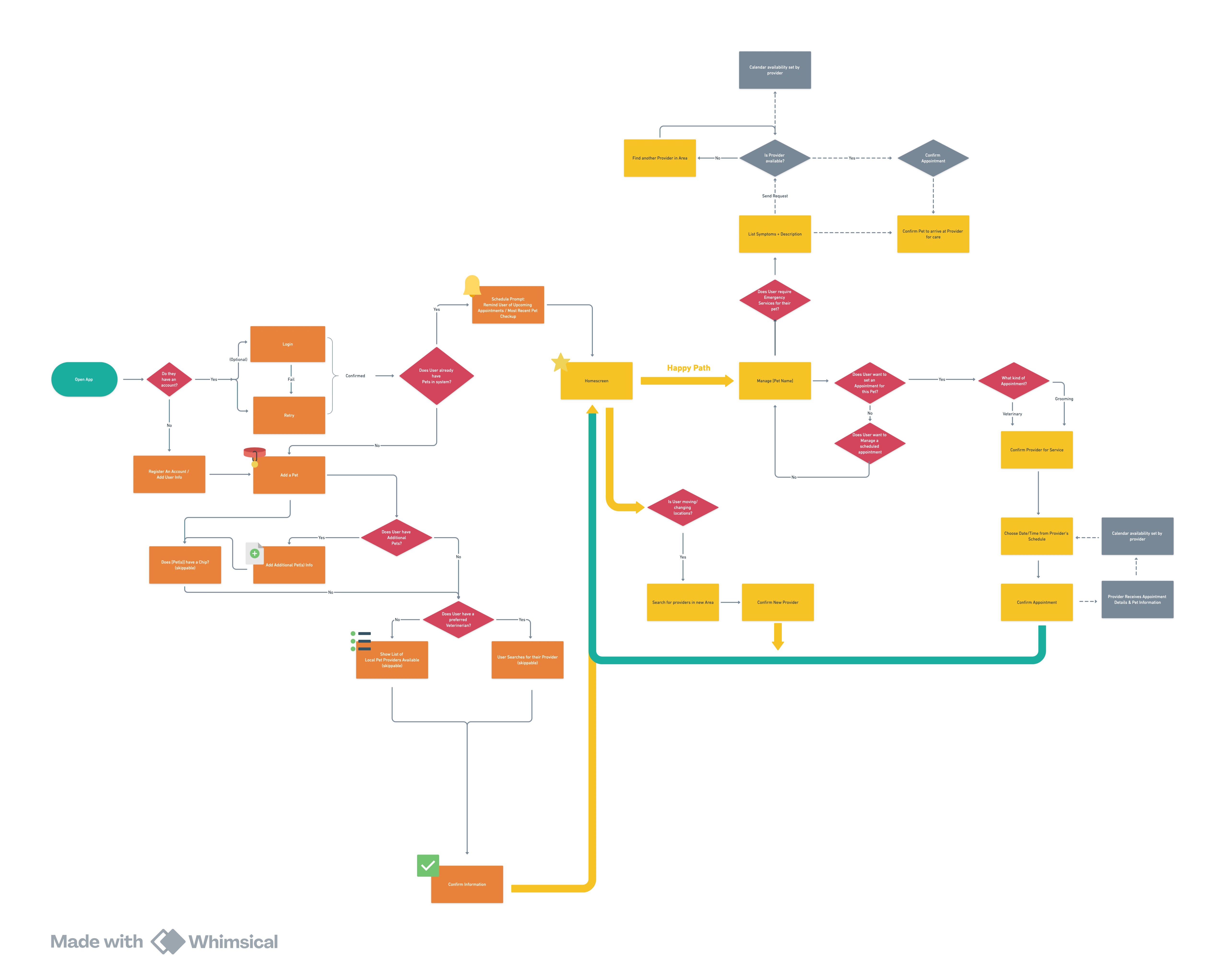
Ideal Customer Journey Mapping (artifact)
From this data I was able to infer that many pet owners, in order to retrieve their pet's documents for dissemination to their pet service providers, often had to go about this through one of various means. In my research, I concluded that on several key areas:
Many pet owners reported that they often had to keep physical files of their pet's medical information either on-hand, or through digital means, meaning they would be unable to or find it difficult to obtain pet health information at a moment's notice, such as when away from the home or traveling.
Some pet providers often allowed for pet owners to defer the handling of a pet's medical information to third-party services, but at a cost.
04 | Wireframing & Component Design
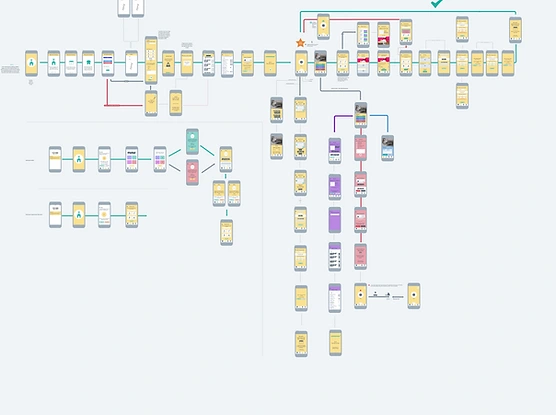
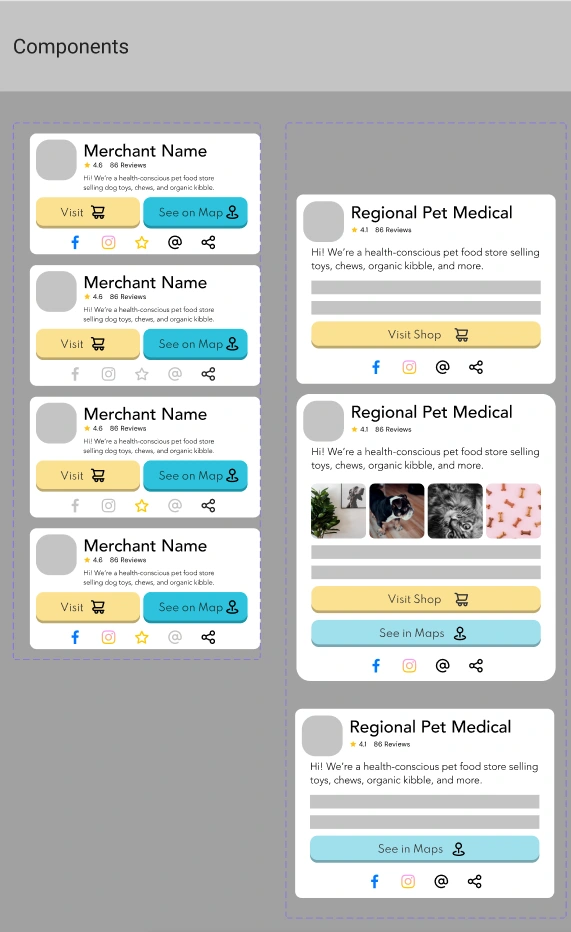
05 | Blockchain & Cryptocurrency Functionalities
In order to securely track transactions and accurately create continuity between visits, pet owners would be able to create virtual representations of their pets on the blockchain, known as Pet Tokens. To create an analogue for this on the Blockchain, I would need to immerse myself in the environment of developers, albeit for a brief stint, in order to understand the complexities behind the technologies.
Luckily, I was able to utilize one of the best resources on the planet for learning about emerging blockchain technologies, and that was https://cryptozombies.io/
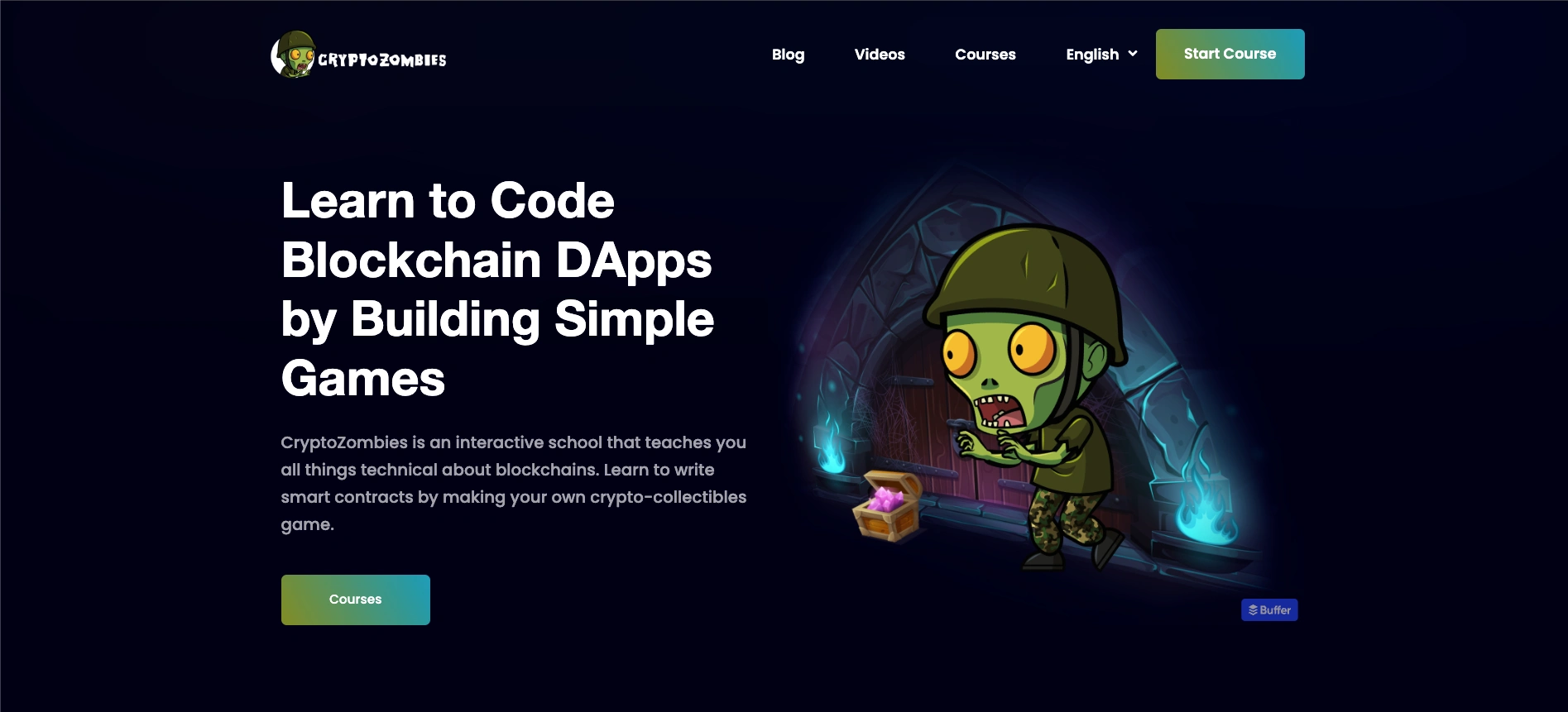
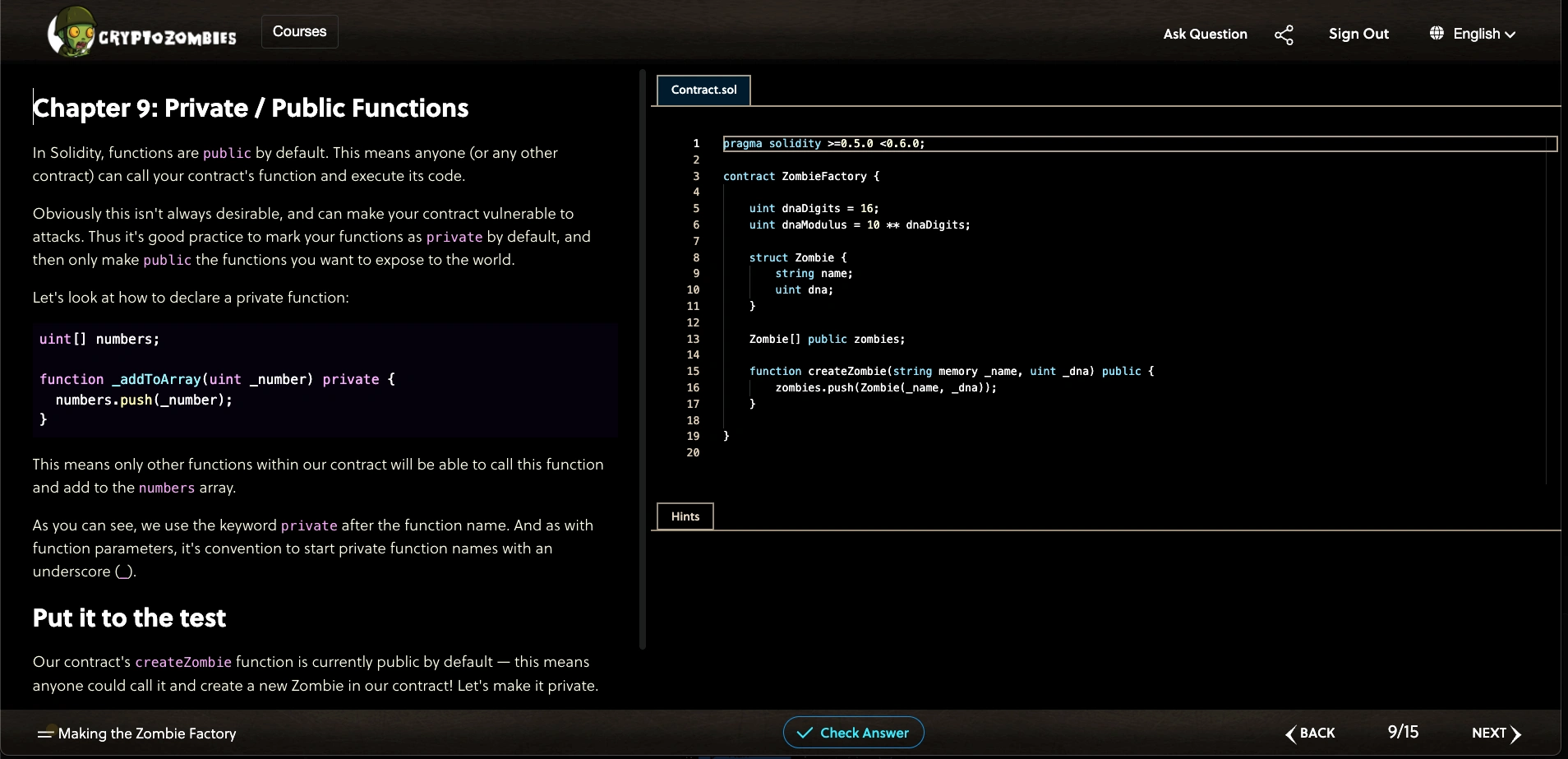
After applying myself for a few weeks to familiarize myself with how functions like Tokens and Smart Contracts worked, I became more secure in my knowledge of blockchain and was able to utilize these advanced methods to improve my designs.
The concept of Pet Tokens was inspired by ERC-721 standards used in non-fungible tokens (NFTs), allowing each pet’s data to be stored as a unique digital asset on the blockchain. These tokens would securely contain a pet’s health history and identity, encrypted using public-key cryptography, ensuring that only the pet owner or an authorized service provider with access privileges could decrypt and view the information.
Additionally, Smart Contracts allowed for automated transactions and permissions—such as scheduling vet appointments or sharing documents—without relying on a central authority. By using a Proof-of-Stake consensus mechanism, the platform would ensure energy efficiency, scalability, and resistance to common exploits like fraud & Sybil attacks.
Integrating these technologies not only enhanced the platform's security but also promoted data ownership and transparency—key values in decentralized digital ecosystems.
Now, using this technology everything from scheduling pet appointments to purchasing goods & services would be managed through the pet owner's wallet, each one containing their respective Pet's unique Token.
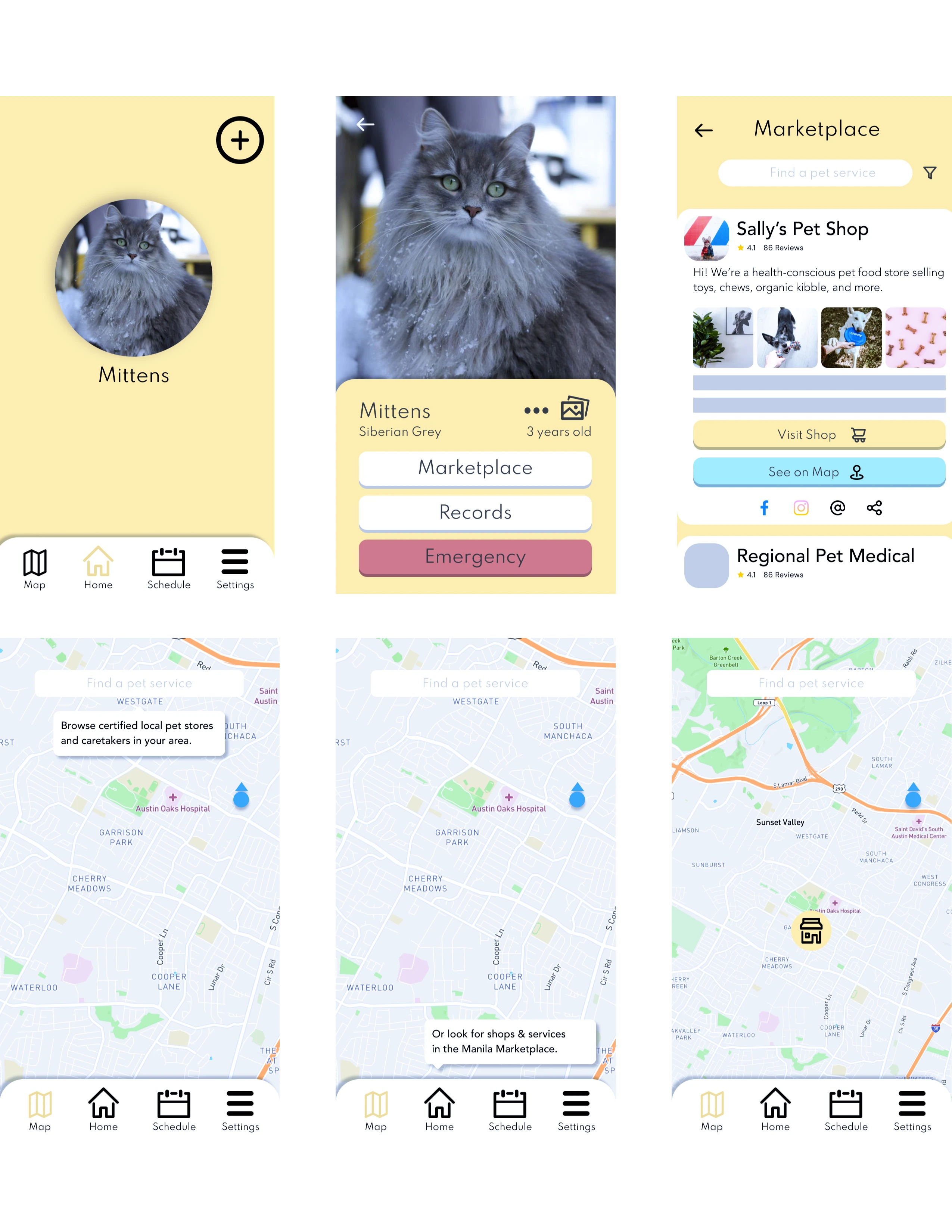
06 | Interactive Maps
Registered Pet owners would have access to a map populated with certified pet service providers within the platform's ecosystem.
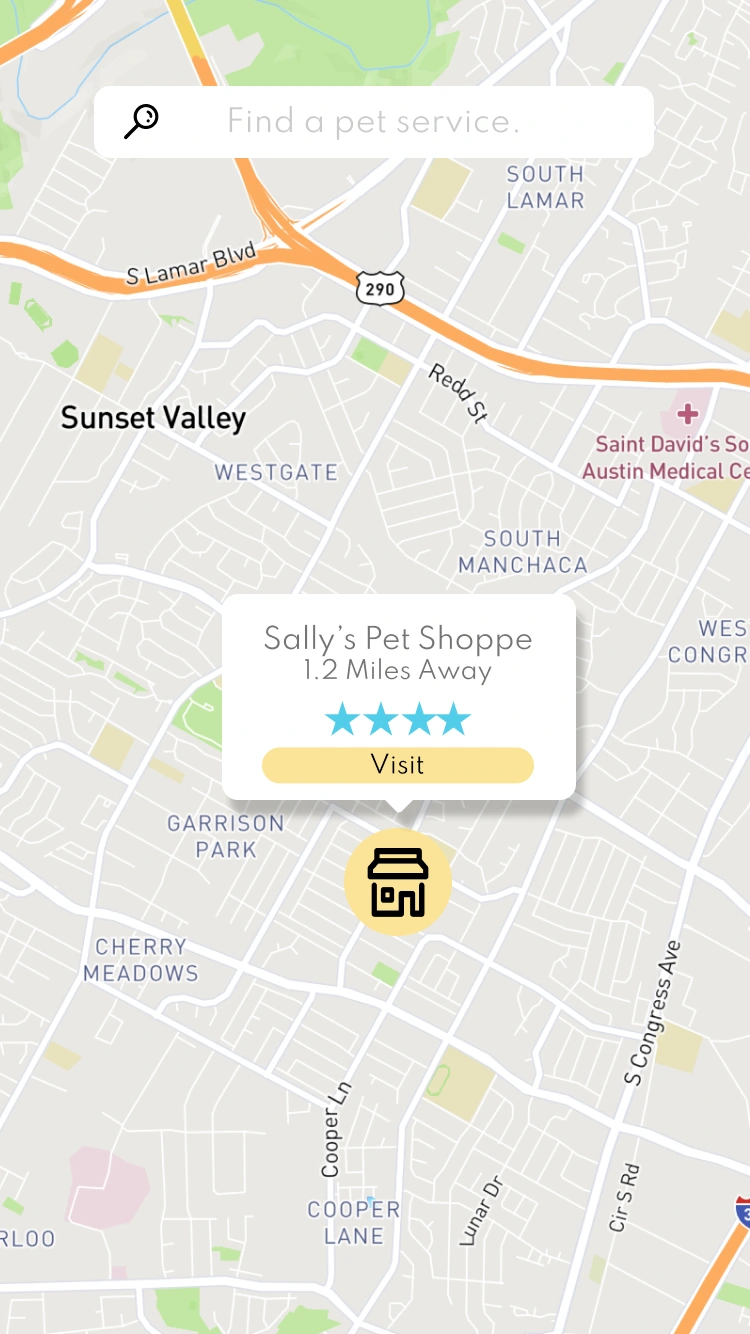
07 | Feature III
Integrated Marketplace
Users would be able to visit a decentralized Marketplace where Verified Pet Providers offering services such as bathing/grooming, veterinary, hospice, & pet hotel services would be able to openly list their goods and services.
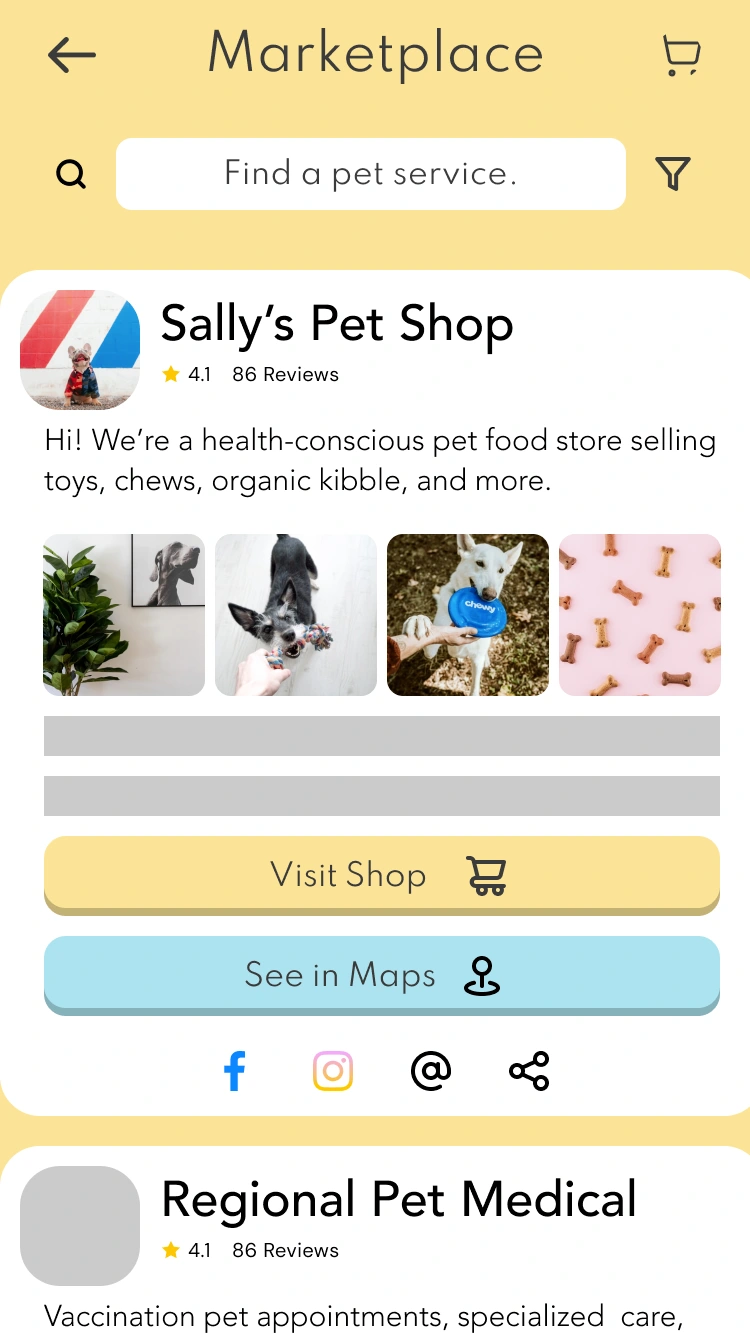
The identities between registered users and pet service providers will be hidden, visible only through their wallet addresses within a Smart Contract.
Users can schedule services & order pet products at their leisure, all while using Smart Contracts that utilize Proof-of-Stake for facilitating transactions.
08 | In Summary
What I Learned
This project deepened my understanding of user-centered design in 2021, especially in the context of emerging technologies like blockchain integration. Through user interviews and research, I learned the importance of validating assumptions early—particularly how pet owners manage health information and navigate emergencies. Many users still rely on fragmented systems or physical documents, which underscored the need for seamless digital solutions.
Creating personas and user stories clarified the diverse needs of pet owners and providers, which helped me design intuitive user flows and feature prioritization. The process of mapping out tasks for actions like accessing pet records, scheduling services, and making purchases helped me see how clarity in flow design directly impacts usability.
Designing features for functions that would utilize emerging concepts like Tokens and Smart Contract-based transactions challenged me to think about security, privacy, and transparency in decentralized platforms and how these benefits (& limitations) would ultimately help me achieve a better understanding of how cryptocurrency-based technologies can be utilized by the general public in the near future. I became more comfortable designing for blockchain-based systems and gained a better appreciation for communicating complex tech in simple, user-friendly ways.
In addition to solving everyday problems for pet owners, Pawlet was also designed as a thought experiment: What if decentralized technology could help protect animals on a global scale?

AI-Generated image of an intrepid jungle explorer venturing deep into uncharted territory to rescue an endangered creature.
As part of this project, I aimed to deepen my understanding of how blockchain ecosystems—specifically trustless, transparent identity systems—could serve as a deterrent against animal trafficking and related abuses.
By using Pet Tokens as unique, verifiable identities tied to real-world animals, and linking them to a decentralized registry of care history and ownership, it becomes significantly harder for bad actors to manipulate or obscure an animal’s origin.
The ability to track lineage, medical records, and transfers of ownership in an immutable ledger offers powerful potential—not only for pet care, but for broader ethical issues around wildlife protection, breeding transparency, and the prevention of illegal sales.
This project opened the door for me to explore how design, ethics, and emerging technologies like blockchain can intersect to support both humans and animals in meaningful ways.
Lastly, working on the interactive map and decentralized marketplace allowed me to explore service ecosystems from both provider and consumer standpoints, and how frictionless design can support local economies.
This case study remains as a testament: To create a design concept for a universal pet supply market exchange, where local vets & pet establishments will be able to connect directly with consumers in an openly decentralized market platform.
Only time will tell if this concept will ever become reality.
Like this project
Posted Sep 6, 2024
Case Study for Pawlett, a Dapp (Decentralized App concept) designed by Abraham 'Abe' Trevino in 2020-2021 as a student project.




